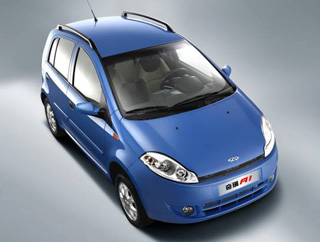
Despite the hype and hoopla, hard evidence indicates homemade Chinese vehicles are not yet ready for major league export markets.
The raw numbers and rate of growth are impressive but can be misleading.
Admittedly, these overseas sales almost doubled year-on-year in 2006 to 343,000 units, boosting China into fourth place among Asian vehicle exporters, after Japan, South Korea and Thailand.
Exports rose another 71% to 241,000 units in the first half of 2007.
But perspective is essential. Almost three-quarters of these shipments are low priced and relatively low-tech trucks and buses, almost all shipped to other emerging markets in Africa, Eastern Europe, Russia, the Middle East and Central and South America, where buyers are easier to please than customers in more advanced industrial nations.
When will these Chinese national brands become globally competitive and able to go bumper-to-bumper with the best-selling passenger vehicles in U.S., European and Japanese showrooms?
"It will take longer than anticipated," warns Ashvin Chotai, director-Asian Automotive Research for Global Insight. "There are a number of challenges, including fit and finish and performance. But the most basic one which Chinese vehicle exports fail to meet is certification, especially safety standards.

"Geely (Automobile Holdings Ltd.) failed quite miserably to meet safety requirements last year in the United States," he points out.
And that wasn’t an isolated case.
In a crash test of its BS6 sedan earlier this year by Germany’s ADAC auto club, Shenyang Brilliance Jinbei Automobile Co. Ltd. received only one star out of five, such a poor performance that early buyers of the vehicle in Belgium reportedly were offered compensation of some kind.
This followed the failure by Jiangling Motors Co. Ltd.’s Landwind SUV in a 2005 ADAC test and raised fresh doubts about the safety and reliability of Chinese-made vehicles.
"Certification should not be a problem," Chotai says. "Chinese auto makers should do their homework and should not go into a market until testing shows they are more than confident their vehicles will pass. They are underestimating the discernment of foreign buyers, especially in Europe."
The lack of preparation and adequate product is understandable, if not forgivable, given how relatively young and immature the typical Chinese vehicle exporter is today.
"Most of these Chinese auto makers are less than 10 years old, some less than five, and used to selling 30,000 to 40,000 vehicles with dated technology domestically each year," says Tim Dunne, director-Asia-Pacific market intelligence for J.D. Power and Associates. "Their export plans make headlines. But it takes time, talent and money to develop an exportable vehicle."
Poor quality remains a major handicap. Tier 1 Chinese suppliers are rare. Foreign auto makers in China, with high standards, typically rely on foreign suppliers for virtually all parts and components not made in-house or imported.
"The Chinese government wants to grow vehicle exports but is wary of too many companies competing too much with each other," Dunne says.
An army of new-vehicle exporters has grown so fast Beijing authorities plan stricter export regulations, including a licensing system aimed at eliminating companies too tiny to compete in world markets.
"There are too many exporters and the exporting business is in chaos, with problems such as cutthroat competition arising," warns Xinhua, China’s official news agency, reporting that 1,025 Chinese enterprises were exporting vehicles in 2005.
Currently, at least, the most practical approach to successful exporting for these beginners, especially those making passenger vehicles, may well be partnership with an established foreign auto maker.
Both Chrysler LLC and Fiat SpA have announced tie-ups with Chery Automobile Co. Ltd. Chrysler plans to develop a car with Chery within about a year, then begin exports to the U.S. and Western Europe in a little over two years. Fiat will produce both Fiat and Alfa Romeo cars in China with Chery but, unlike Chrysler, has not signaled plans to export any re-badged Chery vehicles.
The ability of Chinese auto makers to penetrate successfully into developed markets will depend on such relationships – "not with some importer, but with an OEM partner," Chotai says.
Exports of Chinese passenger vehicles remain in their infancy, a negligible number in 2004 and only 32,000 units in 2005. The number climbed to 93,000 in 2006 and reached 67,000 in the first half of 2007.
"If Honda Motor (Co. Ltd.) succeeds in exporting vehicles from Guangzhou to Europe, other foreign auto makers will establish export bases in China as well," University of Tokyo Associate Professor Tomoo Marukawa predicts. "But it will be 10 to 15 years before significant numbers of national brands are exported to Japan, the U.S. and Europe."
"Most of the near-term growth will be in emerging markets," Chotai adds. "Significant growth will depend on developed markets, and we don’t see that happening until 2009 or 2010 at the earliest.
"By 2012, exports of Chinese passenger vehicles will be between 700,000 and 800,000, a lot of them the Chery-Chrysler kind of volume."
Beyond that, the future is fuzzy. But Beijing leaders are following the example set by Japanese and Korean auto makers in their early years, and where that leads does not bode well for Korean, Japanese, European and U.S. competitors.
Says Dunne: "China is still a bit player in the global vehicle export game, but Chinese leaders have designated autos as one of the ‘pillar’ industries on which the country’s economy is based. They expect the combined value of China’s vehicle and auto parts exports to reach a remarkable $120 billion by 2015, or about 10% of the world’s total vehicle trading volume."




